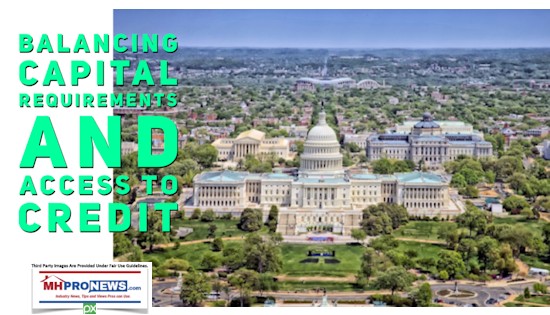
WASHINGTON, D.C. – The Subcommittee on Financial Institutions and Consumer Credit met today. They examined the existing regulatory structure for prudentially regulated financial institutions, with a view to exploring avenues how Congress and regulators can address challenges through policy changes.
“While I believe in robust capital requirements, I don’t think capital should be required to the point that it consolidates risk and eliminates choice in the marketplace for commercial and individual clients. The reality is that we still live in a world where the financial regulatory regime stifles growth and limits the availability of financial products,” said Subcommittee Chairman Blaine Luetkemeyer (R-MO), via a release to the Daily Business News on MHProNews. “We need smarter, tailored regulatory regimes that promote not just transparency, but also effective consumer and systemic protections.”
As many manufactured housing industry professionals know that lived through the credit and capital crunch that began after the industry hit its peak in 1998, these are issues that have be near top-of-mind for business and association leaders.
Key Takeaways from Today’s Hearing
- Under the Dodd-Frank Act, the largest financial institutions were subjected to new rules on matters ranging from capital adequacy guidelines to the creation of living wills.
- The post-financial crisis Dodd-Frank era brought about more aggressive and adversarial relationships between financial institutions and federal financial examiners, even on standards that had been in place for decades.
- Passing regulatory reform is a critical first step to ensure a fairer and balanced federal financial regulatory structure, but much work remains to simplify the complex and overly burdensome system of financial regulation.

Topline Quotes from Witnesses
“With nearly a decade of regulatory changes behind us, now is the time to conduct a holistic review of the post-crisis framework and to make adjustments that would foster greater efficiency and transparency and effectively balance the important goals of a safe and sound financial system with one that best supports economic growth and job creation… Integration of the stress testing and capital regimes to achieve a more simplified and harmonized capital framework is a laudable goal… The Federal Reserve should undertake a broader review of its capital and stress testing programs to ensure that boards of directors at financial institutions can clearly and appropriately make capital management decisions.” – Kevin Fromer, President and CEO, Financial Services Forum.
“The current capital regime has some clear attributes but also some fundamental and important flaws. We now take for granted two of the most important post-crisis reforms… First, capital requirements now focus heavily on common equity rather than hybrid capital instruments that did not prove sufficiently loss absorbing in crisis. Second, off-balance-sheet exposures are now much better captured and capitalized. One could argue that these two changes alone would have been sufficient to prevent a recurrence of the stress on the banking system seen in the last financial crisis. Obviously, regulators did not stop there.” – Greg Baer, President, The Bank Policy Institute.
“The Dodd-Frank Wall Street Reform and Consumer Protection Act (Dodd-Frank) imposed a series of capital regimes on financial institutions with more than $10 billion in total consolidated assets… there are large swaths of Dodd-Frank-related regulatory costs that have nothing to do with the causes of the financial crisis… The bottom line is that in exchange for a safer banking system, the U.S. sacrificed economic vitality and growth. It is difficult to quantify this with any precision… but it underlies the sentiment that Dodd-Frank simply went too far.” – Douglas Holtz-Eakin, President, American Action Forum.
“The U.S. banking sector is an important segment of the economy that serves as the primary provider of credit to our communities, to consumers and small- and large- businesses alike, and is a vital engine of growth and innovation in our economy… today, moderately-sized regional banking organizations with traditional and straight-forward business models that provide communities with their traditional banking needs, such as getting loans and having a place to make deposits, have been generally subject to the same stress testing, risk management, capital, and liquidity requirements that are applied to firms that are materially larger and more complex. These requirements have adversely impacted the lending activities of regional and community banks, and have increased the price of, and reduced the access to, credit for families, small businesses, and other job creators in our economy.” – Keith A. Noreika, Partner, Simpson Thacher & Bartlett.
See the related report, linked below, for some of the bi-partisan movement in capital and credit reforms that are being advanced. ## (News, analysis, and commentary.)
(Third party images, content are provided under fair use guidelines.)
Related Reports:
Jeb Hensarling & Maxine Waters Unveil Bipartisan Capital Markets Reform Legislation
1) To sign up in seconds for our MH Industry leading emailed news updates, click here.
2) To provide a News Tips and/or Commentary, click the link to the left. Please note if comments are on-or-off the record, thank you.
3) Marketing, Web, Video, Consulting, Recruiting and Training Resources


























